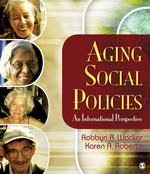Aging Social Policies
An International Perspective
- Robbyn R. Wacker - St. Cloud State University, USA, University of Northern Colorado, USA
- Karen A Roberto - Institute for Society, Culture and Environment, Virginia Tech University, USA
Comparative Public Policy | Comparative Social Policy | Public Policy and Aging (General)
Key Features
Two approaches—international comparisons on aging and the relationship between macro social policy and real people's lives—provide the foundation for understanding aging social policy.
The connection between macro and micro is reinforced through descriptions of the varied ways in which different countries construct social policies and their direct effect on an older adult's quality of life.
Chapter-opening quotes—from a politician or leader in related fields and from an older adult—demonstrate the policy-person link.
Each chapter concludes with an interview with an older adult, adding a depth of understanding and insight to the human concerns behind the social policies.
this book was not available until class started, we plan to use it next fall
The book did not cover the scope of issues facing families in the context of the course requirement.
Inclusion of the international perspective helps students better understand U.S. aging policy. Otherwise, they are sucked into the misperception that the U.S. way is the only way.
It is working well for my gerontology graduate students. It is good for them to be exposed to different kinds of structures in the ways that support is provided to older adults. The models showing the different structures are especially helpful for my online class.
Level too high for first undergraduate course in policy. May be considered for upper level course.

